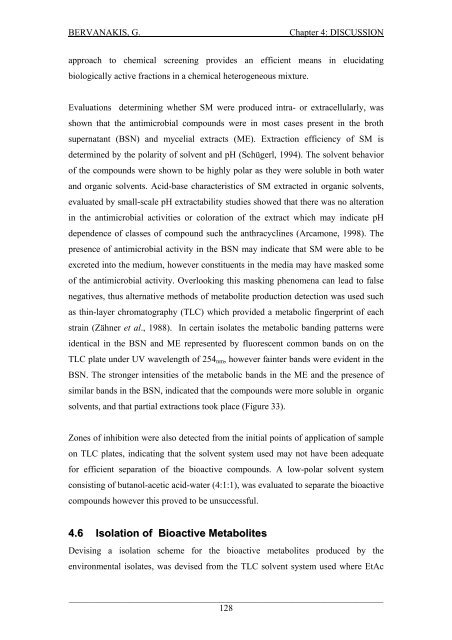Detection and Expression of Biosynthetic Genes in Actinobacteria ...
Detection and Expression of Biosynthetic Genes in Actinobacteria ...
Detection and Expression of Biosynthetic Genes in Actinobacteria ...
You also want an ePaper? Increase the reach of your titles
YUMPU automatically turns print PDFs into web optimized ePapers that Google loves.
BERVANAKIS, G.Chapter 4: DISCUSSIONapproach to chemical screen<strong>in</strong>g provides an efficient means <strong>in</strong> elucidat<strong>in</strong>gbiologically active fractions <strong>in</strong> a chemical heterogeneous mixture.Evaluations determ<strong>in</strong><strong>in</strong>g whether SM were produced <strong>in</strong>tra- or extracellularly, wasshown that the antimicrobial compounds were <strong>in</strong> most cases present <strong>in</strong> the brothsupernatant (BSN) <strong>and</strong> mycelial extracts (ME). Extraction efficiency <strong>of</strong> SM isdeterm<strong>in</strong>ed by the polarity <strong>of</strong> solvent <strong>and</strong> pH (Schügerl, 1994). The solvent behavior<strong>of</strong> the compounds were shown to be highly polar as they were soluble <strong>in</strong> both water<strong>and</strong> organic solvents. Acid-base characteristics <strong>of</strong> SM extracted <strong>in</strong> organic solvents,evaluated by small-scale pH extractability studies showed that there was no alteration<strong>in</strong> the antimicrobial activities or coloration <strong>of</strong> the extract which may <strong>in</strong>dicate pHdependence <strong>of</strong> classes <strong>of</strong> compound such the anthracycl<strong>in</strong>es (Arcamone, 1998). Thepresence <strong>of</strong> antimicrobial activity <strong>in</strong> the BSN may <strong>in</strong>dicate that SM were able to beexcreted <strong>in</strong>to the medium, however constituents <strong>in</strong> the media may have masked some<strong>of</strong> the antimicrobial activity. Overlook<strong>in</strong>g this mask<strong>in</strong>g phenomena can lead to falsenegatives, thus alternative methods <strong>of</strong> metabolite production detection was used suchas th<strong>in</strong>-layer chromatography (TLC) which provided a metabolic f<strong>in</strong>gerpr<strong>in</strong>t <strong>of</strong> eachstra<strong>in</strong> (Zähner et al., 1988). In certa<strong>in</strong> isolates the metabolic b<strong>and</strong><strong>in</strong>g patterns wereidentical <strong>in</strong> the BSN <strong>and</strong> ME represented by fluorescent common b<strong>and</strong>s on on theTLC plate under UV wavelength <strong>of</strong> 254 nm , however fa<strong>in</strong>ter b<strong>and</strong>s were evident <strong>in</strong> theBSN. The stronger <strong>in</strong>tensities <strong>of</strong> the metabolic b<strong>and</strong>s <strong>in</strong> the ME <strong>and</strong> the presence <strong>of</strong>similar b<strong>and</strong>s <strong>in</strong> the BSN, <strong>in</strong>dicated that the compounds were more soluble <strong>in</strong> organicsolvents, <strong>and</strong> that partial extractions took place (Figure 33).Zones <strong>of</strong> <strong>in</strong>hibition were also detected from the <strong>in</strong>itial po<strong>in</strong>ts <strong>of</strong> application <strong>of</strong> sampleon TLC plates, <strong>in</strong>dicat<strong>in</strong>g that the solvent system used may not have been adequatefor efficient separation <strong>of</strong> the bioactive compounds. A low-polar solvent systemconsist<strong>in</strong>g <strong>of</strong> butanol-acetic acid-water (4:1:1), was evaluated to separate the bioactivecompounds however this proved to be unsuccessful.4.6 Isolation <strong>of</strong> Bioactive MetabolitesDevis<strong>in</strong>g a isolation scheme for the bioactive metabolites produced by theenvironmental isolates, was devised from the TLC solvent system used where EtAc_____________________________________________________________________128















